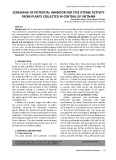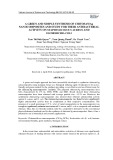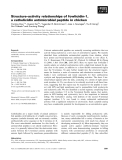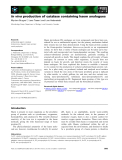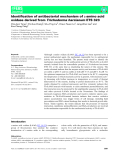
Anti-bacterial agents
-
FtsZ is conserved in almost all bacteria and is an essential protein for bacterial cell division. The cell division is prevented by the inhibitors against FtsZ’s functions. Thus, FtsZ is known as an attractive, and underexploited novel antibacterial target protein. The aim of this research is searching for new antibacterial agents from 72 plants collected in Central Vietnam.
 6p
6p  vifaye
vifaye
 20-09-2024
20-09-2024
 3
3
 1
1
 Download
Download
-
A green and simple approach has been successfully developed to synthesize chitosan/Ag nanocomposites using kumquat extract as a biological reducing agent. It indicates to be an ecofriendly and green method for the synthesis providing a cost effective and an efficient route for the chitosan/Ag nanocomposites’ synthesis. The prepared chitosan/Ag nanocomposites have been characterized by UV-vis, TEM, FTIR, and XRD. Result showed those chitosan/Ag nanocomposites have been obtained with average particle size ~15-25 nm.
 10p
10p  abcxyz123_02
abcxyz123_02
 03-03-2020
03-03-2020
 28
28
 2
2
 Download
Download
-
Cationic antimicrobial peptides are naturally occurring antibiotics that are actively being explored as a new class of anti-infective agents. We recently identified three cathelicidin antimicrobial peptides from chicken, which have potent and broad-spectrum antibacterial activitiesin vitro (Xiao Y, Cai Y, Bommineni YR, Fernando SC, Prakash O, Gilliland SE & Zhang G (2006)J Biol Chem281, 2858–2867).
 13p
13p  inspiron33
inspiron33
 26-03-2013
26-03-2013
 50
50
 4
4
 Download
Download
-
Haem (protohaem IX) analogues are toxic compounds and have been con-sidered for use as antibacterial agents, but the primary mechanism behind their toxicity has not been demonstrated. Using the haem protein catalase in the Gram-positive bacterium Enterococcus faecalisas an experimental system, we show that a variety of haem analogues can be taken up by bac-terial cells and incorporated into haem-dependent enzymes.
 10p
10p  mobifone23
mobifone23
 21-01-2013
21-01-2013
 56
56
 4
4
 Download
Download
-
AlthoughL-amino oxidase (LAAO; EC 1.4.3.2) has been reported to be a potent antibacterial agent, the mechanism responsible for its antibacterial activity has not been identified. The present study aimed to identify the mechanism responsible for the antibacterial activity of Th-LAAO, an LAAO recently isolated from the extracellular proteins of Trichoderma harzianum ETS 323, at the same time as elucidating the nature of this enzyme.
 14p
14p  cosis54
cosis54
 09-12-2012
09-12-2012
 42
42
 4
4
 Download
Download
-
Adverse Reactions Adverse drug reactions are frequently classified by mechanism as either dose-related ("toxic") or unpredictable. Unpredictable reactions are either idiosyncratic or allergic. Dose-related reactions include aminoglycoside-induced nephrotoxicity, linezolid-induced thrombocytopenia, penicillin-induced seizures, and vancomycin-induced anaphylactoid reactions. Many of these reactions can be avoided by reducing dosage in patients with impaired renal function, limiting the duration of therapy, or reducing the rate of administration.
 9p
9p  colgate_colgate
colgate_colgate
 21-12-2010
21-12-2010
 62
62
 4
4
 Download
Download
-
Drug Interactions Antimicrobial drugs are a common cause of drug-drug interactions. Table 127-8 lists the most common and best-documented interactions of antibacterial agents with other drugs and characterizes the clinical relevance of these interactions. Coadministration of drugs paired in the tables does not necessarily result in clinically important adverse consequences.
 8p
8p  colgate_colgate
colgate_colgate
 21-12-2010
21-12-2010
 65
65
 3
3
 Download
Download
-
Principles of Antibacterial Chemotherapy The choice of an antibacterial compound for a particular patient and a specific infection involves more than just a knowledge of the agent's pharmacokinetic profile and in vitro activity.
 9p
9p  colgate_colgate
colgate_colgate
 21-12-2010
21-12-2010
 82
82
 5
5
 Download
Download
-
Distribution To be effective, concentrations of an antibacterial agent must exceed the pathogen's MIC. Serum antibiotic concentrations usually exceed the MIC for susceptible bacteria, but since most infections are extravascular, the antibiotic must also distribute to the site of the infection. Concentrations of most antibacterial agents in interstitial fluid are similar to free-drug concentrations in serum.
 6p
6p  colgate_colgate
colgate_colgate
 21-12-2010
21-12-2010
 72
72
 3
3
 Download
Download
-
Inhibition of Protein Synthesis Most of the antibacterial agents that inhibit protein synthesis interact with the bacterial ribosome. The difference between the composition of bacterial and mammalian ribosomes gives these compounds their selectivity. Aminoglycosides Aminoglycosides (gentamicin, kanamycin, tobramycin, streptomycin, neomycin, and amikacin) are a group of structurally related compounds containing three linked hexose sugars. They exert a bactericidal effect by binding irreversibly to the 30S subunit of the bacterial ribosome and blocking initiation of protein synthesis.
 5p
5p  colgate_colgate
colgate_colgate
 21-12-2010
21-12-2010
 75
75
 3
3
 Download
Download
-
Harrison's Internal Medicine Chapter 127. Treatment and Prophylaxis of Bacterial Infections Treatment and Prophylaxis of Bacterial Infections: Introduction The development of vaccines and drugs that prevent and cure bacterial infections was one of the twentieth century's major contributions to human longevity and quality of life. Antibacterial agents are among the most commonly prescribed drugs of any kind worldwide. Used appropriately, these drugs are lifesaving.
 13p
13p  colgate_colgate
colgate_colgate
 21-12-2010
21-12-2010
 85
85
 8
8
 Download
Download
-
Sulfonamides Antibacterial sulfonamides have a rather high risk of causing cutaneous eruptions and are among the drugs most frequently implicated in SJS and TEN. The combination of sulfamethoxazole and trimethoprim frequently induces adverse cutaneous reactions in patients with AIDS (Chap. 182). Desensitization is often successful in AIDS patients with morbilliform eruptions but is not recommended in AIDS patients who manifested erythroderma or a bullous reaction in response to their earlier sulfonamide exposure.
 5p
5p  konheokonmummim
konheokonmummim
 03-12-2010
03-12-2010
 73
73
 4
4
 Download
Download
-
Introduction: β-Lactum antibiotics constitute an important class of antibacterial agents being used extensively for both humans and food-producing animals to treat or prevent infections. The drugs occasionally cause human deaths due to anaphylactic shock during medical treatments, especially when they are parenterally administered without their prior intracutaneous tests. These cases are usually handled as medical accidents (malpractice), and subjected to autopsies and analysis of the drugs used. These antibiotics are composed of cephems ( Table 10.1) and penicillins ( Table 10.
 8p
8p  bigbaby87
bigbaby87
 01-09-2010
01-09-2010
 103
103
 6
6
 Download
Download
CHỦ ĐỀ BẠN MUỐN TÌM








